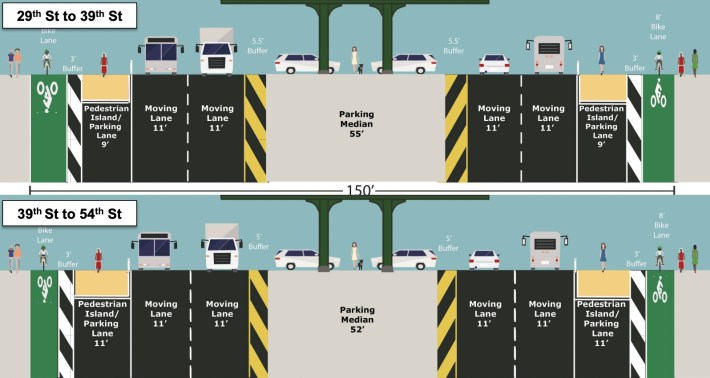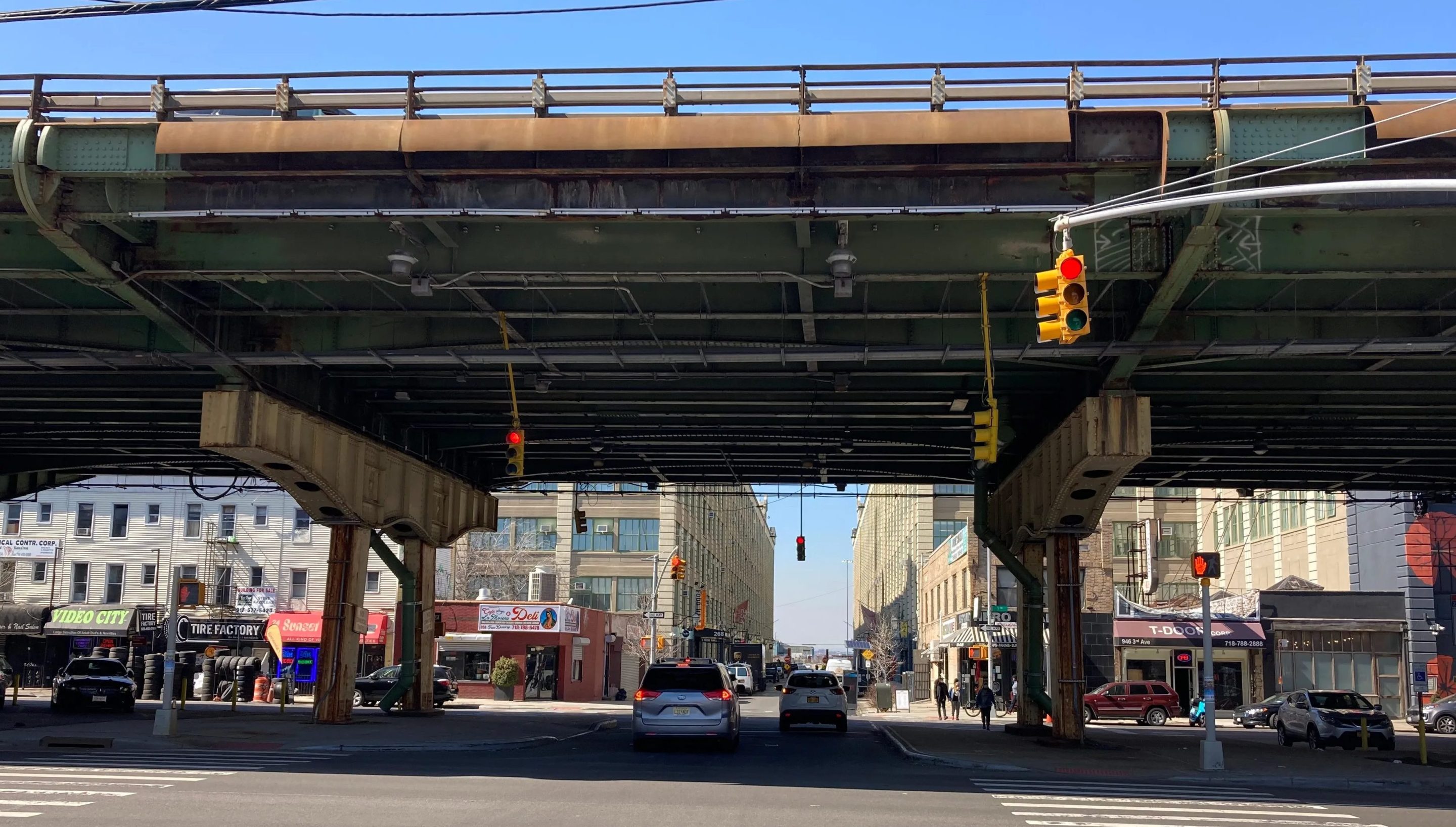Adams administration officials on Wednesday touted new concepts to reconnect communities severed by Robert Moses's Brooklyn-Queens Expressway — yet have apparently wavered on a plan to do just that under the highway in Sunset Park after business interests pushed back on the safety overhaul, Streetsblog has learned.
The city plans to spend a $5.6-million federal grant starting next year to partially design streetscape improvements along two sections of the BQE north and south of the infamous triple-cantilever in Brooklyn Heights, according to information officials shared with a hand-picked group of reporters on Wednesday.
But last week, DOT informed Sunset Park community leaders that it has put a hold on a long-awaited redesign of a deadly stretch of Third Avenue below the BQE originally set for installation this fall due to concerns raised by business groups.
"It’s a little disheartening that the business community and some of their players are trying to — no pun intended — roadblock this project," Brooklyn Community Board 7 Chair Julio Peña told Streetsblog. "Third Avenue — everyone can agree — is unsafe, and we need some radical changes to make it safer for everyone."
DOT earlier this year floated a redesign of the hellish road [PDF] between Prospect Avenue and 62nd Street. One of the options for the redesign would include repurposing one of traffic lane in each direction on the six-lane road to install a parking-protected bike lane and painted pedestrian islands to narrow crossing distances for pedestrians.
CB 7 in February endorsed the road diet option in 32-1 vote, and DOT officials had said they could implement changes in the summer or fall.

Despite that support, agency officials recently told Peña they planned to do more outreach through the end of 2024 after groups, including the Brooklyn Chamber of Commerce and the Southwest Brooklyn Industrial Development Corporation, raised concerns.
Peña said he no longer has "any kind of timeline" for the safety redesign.
"The only thing that they said they would try wrap up these additional conversions and visioning by the end of this year," he told Streetsblog.
The Brooklyn Chamber of Commerce recently circulated an online survey to businesses about the redesign. The poll included leading questions like "How important is a protected bike lane on Third Avenue, given the existing six-mile long protected bike lane on Fourth Avenue and bike lane on Fifth Avenue?"
The questionnaire also asked what impacts businesses foresaw from DOT proposed reduction of car lanes — exclusively offering negative potential answers, such as "significantly impact loading and unloading operations" and "reduce customer volume due to traffic and lack of parking options."
Business owners believe that car drivers are their main customers, but in fact, businesses rely on customers coming by foot or bike. And the questionnaire did not address the safety benefits of road diets, which have proven to reduce the number of people killed and seriously injured by around 30 percent, according to DOT. There have been a whopping 14 fatalities on that stretch of Third Avenue since 2016 — including four pedestrians and four cyclists, according to DOT figures.
"Sunset Park has waited like 20 years ... for the city to do something about Third Avenue," Peña said.
In the name of more "community outreach" after objection from business owners, the Adams administration has repeatedly delayed, watered down, or flip-flopped on projects, including on McGuinness Boulevard, Ashland Place, and Underhill Avenue, and on the Bronx's Fordham Road.
Brooklyn Chamber of Commerce CEO Randy Peers was a key opponent of the proposed road diet on McGuinness Boulevard, which he claimed would harm businesses along that northern Brooklyn corridor. The opposition of the business community was cited by Adams administration officials for why the pulled back from the fullest redesign for more than a year, though shortly after the mayor was incited for alleged corruption, city officials restored part of the road diet plan.
Southwest Brooklyn Industrial Development Corporation Executive Director Jesse Solomon said her local business development group supports safety fix on Third Avenue, but has "concerns" about the design, and that the group was awaiting more traffic analysis by DOT.
"We have expressed some concerns ..., given that Third Avenue is a truck route in a heavy industrial area and serves a critical function for freight mobility throughout the borough," Solomon said in a statement provided to Streetsblog.
DOT in a presentation last year noted that the same stretch of Fourth Avenue — which is also a truck route and already mirrors the design of the road diet for Third Avenue — has logged less than one-third the number of fatalities.
A DOT spokesperson confirmed that the agency is going to collect more "data," arguing that it didn't present a "full design" to the community board.
"Third Avenue is a complex corridor, and we are doing more data collection as we continue community outreach to develop a design," spokesman Vin Barone said in a statement. "We know it's critical to advance safety measures on the avenue and we plan to do so."
Meanwhile, agency officials on Wednesday presented a slate of renderings for improvements to the areas around the Moses-era highway to a hand-picked group of reporters, according to a recording of the closed-door meeting obtained through sources.
DOT declined multiple requests to allow Streetsblog to join the closed-door briefing, whose participants included the Daily News, amNY, WNYC/Gothamist, NY1, the New York Times and the Brooklyn Eagle. Agency chief of staff Ryan Lynch told Streetsblog at an unrelated event on Wednesday that the agency often bars some reporters from on-the-record briefings and question-and-answer sessions.
“Targeted briefings happen all the time,” he said when asked to justify why Streetsblog was initially not invited, then thrown out of the virtual briefing after logging on anyway:

The agency received $5.6 million from the federal Reconnecting Communities program earlier this year for initial design work on a proposal for part of the northern and southern section of the highway, Deputy Mayor Meera Joshi said at the briefing.
Officials presented possible revamps like capping trench sections of the highway, or repurposing the space underneath elevated portions, for example markets, delivery microhubs, bike parking, metered car parking, or electric car charging.
Joshi said the visuals came out of feedback sessions where DOT collected ideas from locals "who live every day in the shadow of the BQE," adding that the agency would "pick out a few of them, and take them to the next stage" in the years-long process.
"These are the communities we needed to reach that weren’t talked to at all decades ago when the BQE was built," Joshi said.
But the grant only funds up to 30 percent of the design process of proposals. DOT doesn't plan to launch public engagement until early next year, DOT's Chief Strategy Officer Julie Bero told the reporters.
Projects like capping even one block and adding the required ventilation, building "pedestrian connectors," or making "comprehensive under-the-elevated improvements" cost hundreds of millions of dollars.
The agency also applied — albeit unsuccessfully — for $800 million in Biden infrastructure bucks for its $5.5-billion project to rebuild the city-owned crumbling BQE cantilever to last another century, officials announced earlier this year.
Environmental justice groups along the highway corridor slammed the Adams administration at the time for doubling down on the mistakes of the past by shoring up the highway for another 100 years.
The BQE sections to the north and south are state-owned and the city owns just those 12 percent of the highway in Brooklyn, between Atlantic Avenue and the Brooklyn Bridge. State officials have said they have "no plans" to redesign their parts of the expressway.






